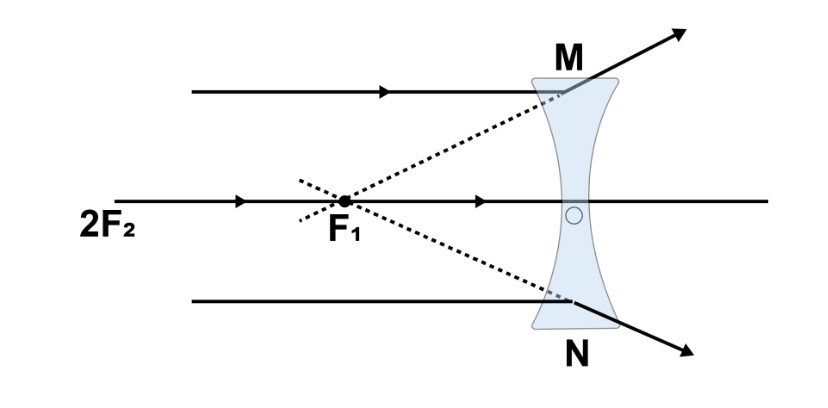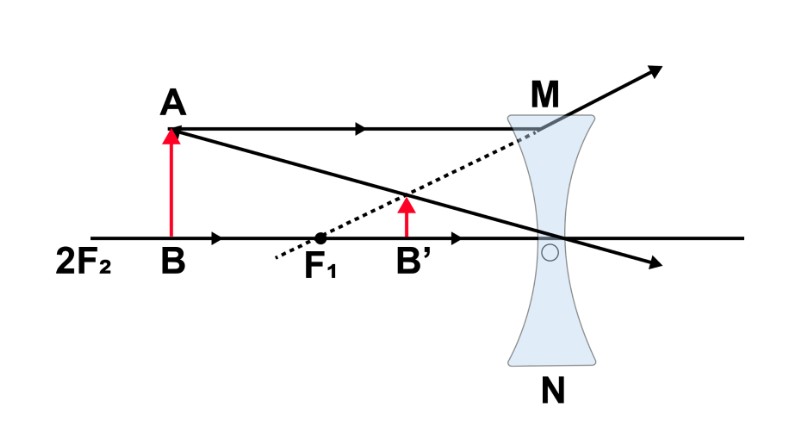
Concave Lens
Oct 13, 2022, 16:45 IST
The lens is one of the significant discoveries of humans. Although it is impossible to say when or how the lens was discovered, it is clear that ancient people realized at some point in the past that they could manipulate light using a piece of glass. For example, people use a lens to make distant objects appear closer; small objects appear larger and blurry objects appear bright (i.e., magnifiers and corrective lenses). The lenses used to perform these tasks fall into two categories of simple lenses, such as convex and concave lenses. This article will discuss about the concave lens and its properties.
| Table of Content |
What is a Concave Lens?
A Concave Lens is a lens where it diverges a direct light beam from a source into a scaled-down, upright virtual image. It can create both the real and virtual images. Concave lenses have at least one surface curved inward. A concave lens is also diverging because it is shaped inward at the center and bulges outward over the edges, spreading the light. They treat myopias because they make distant objects appear smaller than they are.
History of Concave Lens
The term lens is derived from the word lēns. The Latin word names the lens because a doubly convex lense has the shape of a lens. The plant lens also gives its name to a geometric figure.
Some scholars have even claimed that the evidence from the archaeological age indicates the widespread use of lenses in ancient times that lasted for several millennia.
Different people have even suggested that Egyptian or some hieroglyphs depict a simple glass meniscus.
The earliest reference to the use of lenses is from Aristophanes' play, The Clouds. We can say 424 BC mentions glass that burns. Pliny, the Elder from the 1st century himself, confirms that burning glasses were already known in Roman times.
Pliny also tells us the earliest known reference to corrective lenses when he mentions that Nero was said to have watched gladiator games using an emerald, presumably concave, to correct nearsightedness, an admittedly vague reference. Seneca and Pliny, who are younger, i.e., 3 BC – 65 AD, described the magnifying effect of a glass sphere filled with water.
Concave Lens Formula
The lens formula is used to identify the nature and the position of the image formed by the concave lens. The lens formula is expressed as follows:
1/f= 1/v + 1/u
where f = focal length
v = distance of the image from the centre
u = distance of the object from the centre.
Similarly, the magnification of the image is given by the equation,
M = hi/ho =v/u
where M is the magnification, hi is the height of the image, and ho is the height of the object.
Image Formation in Concave Lens
An object is placed at infinity and forms a virtual image at the focus. The size of the image is much smaller than that of the object.

An object is placed at a finite distance from the lens and forms a virtual image between pole and the focus of the convex lens. As a result, the size of the image is smaller than that of the object.

Uses of Concave Lens
Some uses of the concave lens are given below:
- Telescope
Concave lenses are used in binoculars and binoculars to magnify objects. Because a convex lens creates blurring and distortion, telescope and binocular manufacturers install concave lenses in front of or inside the eyepiece to help focus better.
- Eye Glasses
A Concave lenses are most often used to correct myopia, also called myopia. The eyeball of a person with myopia is too long, and images of distant objects do not reach the retina. Therefore, concave lenses are used in glasses, which correct the deficiency by spreading light rays before they reach the eyeball. This allows a person to see the distant objects more clearly.
- Laser
A Laser beams are a technology that is used in many devices. Laser beams are used by several types of medical equipment, scanners, CD players, DVD players, and many other devices. Laser beams are generally highly focused and must be diffused to ensure proper tool operation. A concave lenses are used to disperse the focus of the laser beams and provide the proper functioning of the device. Small concave lenses are usually used for this because they broaden the laser beam and allow it to access a specific area. This is how a concave lenses are used for laser beams.
- Cameras
In cameras, use not only concave lenses but also convex lenses. Concave lenses are combined with convex lenses in cameras to improve the quality of photographs. Using only convex lenses or concave lenses causes distortion and other unwanted effects on the camera. A combination of both the concave and convex lenses is therefore used to eliminate all unwanted effects in the camera.
Frequently Asked Question (FAQs)
Q1. What is Plano concave lens?
Ans . A Plano concave lens is defined as an optical lens with one flat surface and one concave surface. It has a focal length that is negative and can also be used for beam expansion, light projection, or to increase the focal length of an optical system.
Q2. In which condition is concave lens used?
Ans. Concave lenses are most generally used to correct myopia which is also called nearsightedness. The eyeball of a person suffering from myopia is too long, and the images of faraway objects fall short of the retina.
Q3. What are the different types of Concave Lens?
Ans. The different types of concave lens are:
- Biconcave lens,
- Plano-concave lens
- Convexo-concave lens
Q4. Are concave lens thicker in the middle?
Ans. A concave lens is more thicker at the edges than it is at the center, and convex lens is also thicker in the middle than it is at its edges.
Q5. Which lens is used in door?
Ans. Convex lenses are used in peepholes of house doors for security to provide a view of people or objects outside the doors.









